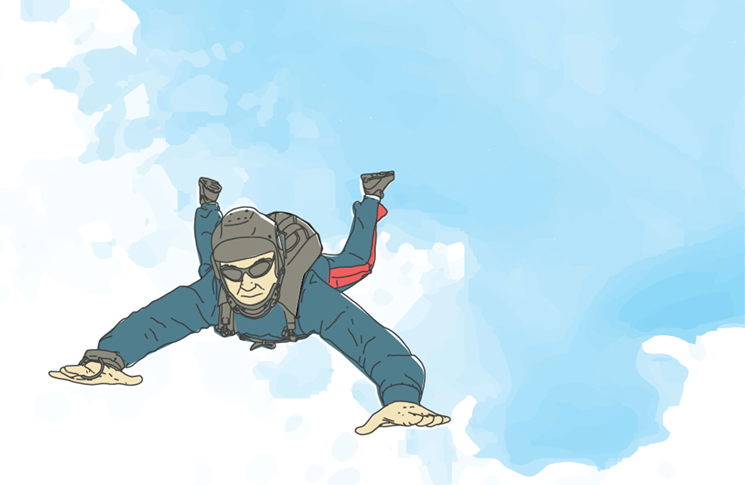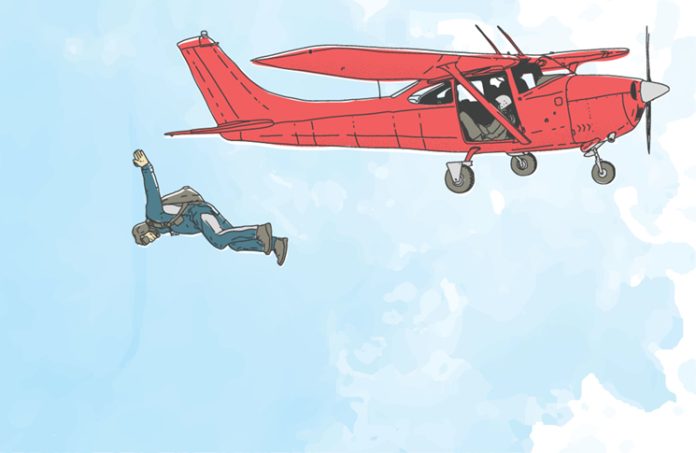A jump pilot becomes acquainted with the particular hazards of this sport in a story that reflects standards at the time it took place.
We needed to get 4 parachutists to the drop zone for a last jump. It was late in the day, but this could have been truly a last jump for them and a last flight for me.
This incident happened at Camden Airport in NSW. (Camden is no longer used for parachuting.)
I was towing gliders at the time, when I got a call from the lead jump master that he needed a pilot urgently. I had flown for them before and, being keen on building my hours in a C182 rather than mainly Pawnees and Super Cubs, I jumped at the opportunity.
When I got there, the regular C182 was ready to go, as the duty pilot had finished for the day and partially refuelled for the next day’s ops and gone home. The C182 was never fully fuelled as the drop zone was close by and an over-weight aircraft is never a good option.
Four skydivers were waiting – a jump master and 3 jumpers; I recognised 3 of the people, along with one new guy. That was one more jumper than normal as we usually fly with 2 or 3 skydivers. My understanding was that the new guy was on a qualifying jump. The all-up weight was higher but within limits.
I had towed heavy gliders behind a 182C from short grass strips so, even with all on board, a 5,000-foot sealed runway should give the aircraft (and me) no problems.
We loaded up, with the new guy down the back, the 2 regulars in the middle and the jump master in the front next to me with his back to the instrument panel so he could observe all that was going on and control the sortie.
We lined up, got clearance to go and I opened the throttle. The aircraft accelerated a bit slower than normal but we got off the deck with plenty of room to spare when suddenly, at 200 to 300 feet, the jump master lurched towards the back of the aircraft. Unfortunately for me, his parachute pack had somehow snared the pitch control and put the prop into full coarse! With a constant-speed propellor aircraft, you need full fine pitch on take-off to get a grip on the air at relatively low speeds.
The sound of the change in prop pitch was heard all over the aerodrome and as my fellow tug pilots told me later, they could not understand ‘what the hell was I doing’.
A split second after the pitch note change, I realised what had happened and grabbed the jump master’s helmet to pull him back against the instrument panel. Fortunately for me, he was an experienced aviator – when he heard the pitch change, he instinctively stopped moving, thereby allowing me to pull him back and regain effective engine power (through fine pitch), maintain control and resume the climb out. Mind you, we were all a bit shaken.
We cleared the trees at the end of the runway and continued the climb out to a safe altitude. Do we go back or continue to the drop zone? As we were now safe and the 2 regular jumpers did not want to waste the opportunity to jump, we went to the drop zone and off-loaded them. I returned with the jump master and new guy still on board. You may well ask – why did they return rather than jump?
Why did the jump master lurch towards the back of the aircraft? From the start, I had noticed he appeared to have been keeping a close watch on the new guy and generally talking to him a lot. That’s probably reasonable for a qualification jump, I figured. However, this guy was acting nervously, fiddling with his reserve chute at the start of the take-off run.
It was the sudden realisation by the jump master that the pins on the reserve could pop at any moment that prompted him to act quickly. He knew what could happen if the reserve chute deployed inside the cabin with the door open and at low altitude.
He lurched towards the guy in an attempt to get to him before the pins popped but, unfortunately, they did pop. When I grabbed the jump master’s helmet to pull him back, the other 2 jumpers saw the danger and forced the new guy down on top of his reserve chute.

A second problem, along with parachute harness snagging the pitch lever, was that, by focussing intently on the possible deployment of the reserve chute, the jumper master had overlooked that a rapid move all the way to the back of the aircraft would have shifted the CG aft – at our weight and low speed, that would most likely have caused a sudden nose up with potential loss of control. At our low height and speed, the jumpers could not have exited the aircraft and I would have had to somehow get the 182 safely back down, with limited control, through the trees at the end of the runway.
Also, why was the new guy fiddling with his reserve chute inside the aircraft? This is not normal practice under any circumstances. In fact, the new guy had recently developed an anxiety issue with jumping and was on a check jump to determine his future in the sport. Apparently, the other jumpers were going along with him in support. I don’t think that having this knowledge at the time would have influenced my decision to go as I would not, in my wildest dreams, have anticipated such an incident to occur.
I did fly for that sky diving club again (but always checked the jump master’s proximity to the panel) and was involved in 2 more potentially near-fatal incidents, not to me or the 182C, but 2 other jumpers early in their sky diving careers. Both incidents were classified as accidental events that occurred outside the aircraft.
Later, a Cessna with a load of jumpers onboard crashed on take-off from a nearby parachuting airstrip, resulting in fatalities and serious injuries. That was rather sobering as I do believe luck was very much on my side that day – our take-off could also have gone horribly wrong as it did for those in that aircraft.
Lessons learnt
An emergency usually happens when you least expect it. It can take only a few seconds to develop and end just as quickly, one way or another. We all learn from emergencies – or should.
The design of the C182 means it is more likely the old aircraft saved us on that day, rather than any actions I took.
Have you had a close call?
Often the experience is something you’ll never forget and you’ve learnt a valuable lesson. Why not share your close call so others can learn from it too?
Articles should be between 500 and 1,000 words. Email fsa@casa.gov.au with your story or a request for a call back. If we publish your story, we’ll give you $500 for an article you’re written or $250 for a story over the phone.






Thank you for sharing your experience.
I firmly believe that ‘expertise’ is a summation of events that ended well. Unfortunately, many of us failed to become ‘experts’.
Sharing our expertise can help other people not to fall into the same problem, although expertise, to be such, must be lived by the ‘actor’.
Best regards!